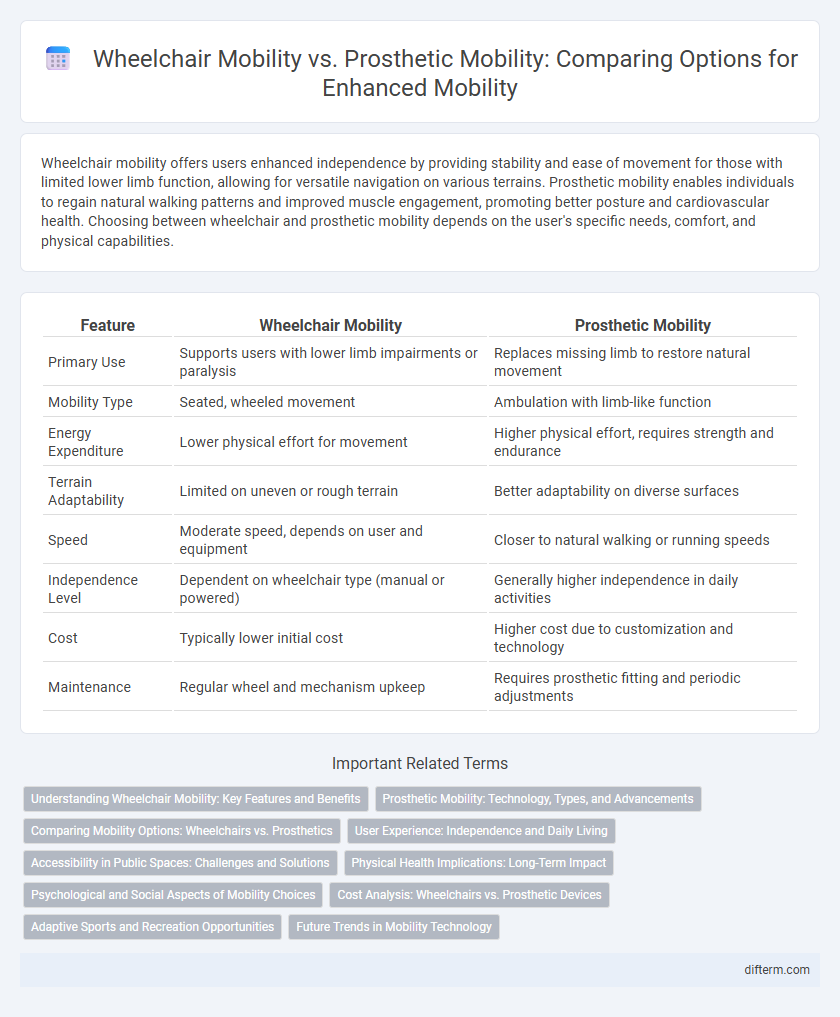Wheelchair mobility offers users enhanced independence by providing stability and ease of movement for those with limited lower limb function, allowing for versatile navigation on various terrains. Prosthetic mobility enables individuals to regain natural walking patterns and improved muscle engagement, promoting better posture and cardiovascular health. Choosing between wheelchair and prosthetic mobility depends on the user's specific needs, comfort, and physical capabilities.
Table of Comparison
| Feature | Wheelchair Mobility | Prosthetic Mobility |
|---|---|---|
| Primary Use | Supports users with lower limb impairments or paralysis | Replaces missing limb to restore natural movement |
| Mobility Type | Seated, wheeled movement | Ambulation with limb-like function |
| Energy Expenditure | Lower physical effort for movement | Higher physical effort, requires strength and endurance |
| Terrain Adaptability | Limited on uneven or rough terrain | Better adaptability on diverse surfaces |
| Speed | Moderate speed, depends on user and equipment | Closer to natural walking or running speeds |
| Independence Level | Dependent on wheelchair type (manual or powered) | Generally higher independence in daily activities |
| Cost | Typically lower initial cost | Higher cost due to customization and technology |
| Maintenance | Regular wheel and mechanism upkeep | Requires prosthetic fitting and periodic adjustments |
Understanding Wheelchair Mobility: Key Features and Benefits
Wheelchair mobility offers enhanced independence and accessibility for individuals with limited lower limb function through features like adjustable seating, powered controls, and customizable support. It provides smooth maneuverability on diverse terrains and reduces the risk of pressure sores with advanced cushioning options. Unlike prosthetic mobility, wheelchairs accommodate a broader range of mobility impairments, enabling users to conserve energy while improving overall comfort and safety.
Prosthetic Mobility: Technology, Types, and Advancements
Prosthetic mobility has advanced significantly with breakthroughs in bionic limb technology, offering users enhanced functionality through microprocessor-controlled joints and lightweight materials such as carbon fiber. Types of prosthetics vary from below-knee and above-knee prostheses to upper-limb prosthetics, each designed to optimize movement and comfort based on the user's specific mobility needs. Innovations like sensory feedback systems and adaptive motor control have dramatically improved the ability of prosthetic users to perform complex tasks with greater precision and reduced fatigue.
Comparing Mobility Options: Wheelchairs vs. Prosthetics
Wheelchairs provide enhanced mobility for individuals with lower limb paralysis or severe muscle weakness, offering immediate independence and versatility across various terrains. Prosthetics enable ambulation by replacing missing limbs, promoting natural gait and muscle activity but often require adaptation and physical conditioning. Comparing these options involves evaluating factors like user lifestyle, physical capabilities, and desired mobility outcomes to determine the most effective solution.
User Experience: Independence and Daily Living
Wheelchair mobility offers immediate and stable support for users, enhancing independence in daily activities such as navigating indoor spaces and resting comfortably. Prosthetic mobility provides a more natural gait and increased freedom in varied terrains, improving long-term physical health and self-confidence. User experience varies significantly, with wheelchair users prioritizing convenience and stability, while prosthetic users focus on adaptability and integration into diverse environments.
Accessibility in Public Spaces: Challenges and Solutions
Wheelchair mobility often faces significant barriers in public spaces due to uneven surfaces, narrow doorways, and lack of ramps, restricting access to essential services and transportation. Prosthetic users encounter challenges related to the design of tactile paving, stair accessibility, and adaptable seating, which impact their independent movement and comfort. Enhancing accessibility involves implementing universal design principles, such as wider pathways, adjustable fixtures, and improved signage, ensuring inclusivity for both wheelchair users and prosthetic users in public environments.
Physical Health Implications: Long-Term Impact
Wheelchair mobility can lead to secondary health issues such as pressure sores, muscle atrophy, and decreased cardiovascular fitness due to prolonged sitting and limited lower body engagement. Prosthetic mobility encourages weight-bearing activities and muscle use, promoting better bone density and cardiovascular health over time. Long-term physical health outcomes depend on proper device use, rehabilitation, and individual health status, with prosthetics generally supporting more dynamic physical activity.
Psychological and Social Aspects of Mobility Choices
Wheelchair mobility often fosters a sense of community through shared experiences and accessible social environments, while prosthetic mobility can enhance feelings of independence and body integrity. Psychological impacts include self-identity and confidence, with prosthetic users sometimes experiencing greater societal acceptance and wheelchair users facing stigma. Social aspects also influence mobility choices, as support networks and accessibility shape how individuals adapt and engage in social activities.
Cost Analysis: Wheelchairs vs. Prosthetic Devices
Wheelchair mobility typically incurs lower initial costs compared to prosthetic devices, with basic wheelchairs priced between $500 and $3,000, whereas prosthetics can range from $5,000 to over $50,000 depending on complexity and customization. Maintenance and replacement expenses also vary, as wheelchairs require regular upkeep but generally less costly parts, while prosthetics demand frequent adjustments and specialized repairs that can significantly add to long-term costs. Insurance coverage often differs, with many policies offering better reimbursement rates for wheelchairs than for high-end prosthetic devices, influencing overall affordability and access.
Adaptive Sports and Recreation Opportunities
Wheelchair mobility offers extensive adaptive sports opportunities such as basketball, rugby, and wheelchair tennis, fostering community engagement and physical fitness. Prosthetic mobility enables participation in activities like running, cycling, and skiing, providing dynamic movement and performance adaptation. Both mobility aids significantly enhance access to recreation, promoting inclusivity and independence in adaptive sports environments.
Future Trends in Mobility Technology
Emerging advancements in wheelchair mobility focus on integrating AI-powered navigation systems and lightweight, durable materials to enhance user independence and comfort. Prosthetic mobility technology is rapidly evolving with the incorporation of neural interfaces and adaptive sensors, enabling more natural and intuitive limb control. Future trends in mobility technology emphasize seamless integration of smart devices and personalized customization to improve overall mobility experiences for users.
wheelchair mobility vs prosthetic mobility Infographic

 difterm.com
difterm.com